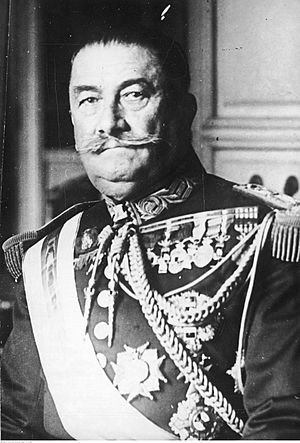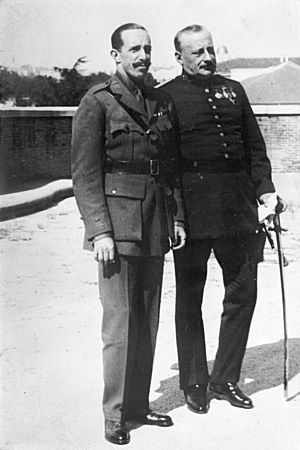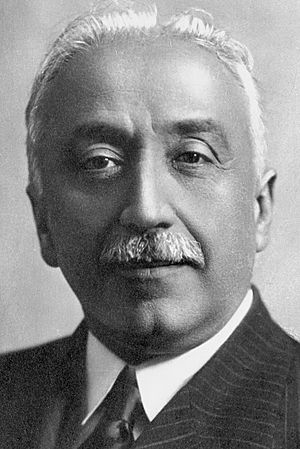Dictablanda of Dámaso Berenguer facts for kids
The Dictablanda of Dámaso Berenguer was a time in Spain's history when General Dámaso Berenguer was in charge. The word dictablanda means "soft dictatorship". It's the opposite of dictadura, which means "hard dictatorship". This period was the very end of the Spanish Restoration era and the end of King Alfonso XIII’s rule.
During this time, there were two main governments. First, Dámaso Berenguer became president in January 1930. His main goal was to bring back "normal" constitutional rules after the dictatorship of Miguel Primo de Rivera. About a year later, Juan Bautista Aznar took over as president. His government eventually led to the start of the Second Spanish Republic. The press used the term dictablanda because Berenguer's government wasn't a strict dictatorship, but it also didn't fully bring back the old 1876 Constitution.
Contents
Why Things Didn't Go Back to Normal
King Alfonso XIII chose General Dámaso Berenguer to be president on January 28, 1930. The King wanted to return Spain to "constitutional normalcy." This meant going back to how things were before the 1923 military takeover. However, many people, including historians, said this was impossible. The King had supported Primo de Rivera's dictatorship for six years. This meant the Monarchy was now linked to the dictatorship, not to the old Constitution.
Many politicians and legal experts believed it was impossible to simply go back to the old ways. They pointed out that Spain had been without its Constitution since 1923. The King's rule was based on a military takeover, not on a written law. This made the Monarchy seem weak and out of touch.
General Berenguer also had trouble forming his government. The two main political parties from before the dictatorship had basically disappeared. They were not real political parties but groups that just wanted power. Many politicians refused to work with Berenguer. This meant the King's government had no strong political groups to help guide the country.
Berenguer's actions were very slow. This made people doubt if he really wanted to bring back "constitutional normalcy." Because of this, newspapers started calling his rule the "dictablanda" or "soft dictatorship." Some politicians who used to support the King even started saying they were "monarchists without a King." Others joined the Republican side, wanting a new type of government.
A famous writer, José Ortega y Gasset, wrote an important article in November 1930. He said, "Spaniards, your State does not exist! Rebuild it! Delenda est Monarchia" (which means "The Monarchy must be destroyed"). This showed how many people felt about the King's rule.
The King Loses Support
Throughout 1930, it became clear that the King's government was losing support from almost everyone. Groups that had always backed the Monarchy, like business owners, stopped trusting it. They worried the King couldn't handle the country's problems.
The King also lost the support of the middle class. Many people in this group were starting to like ideas about democracy and socialism. Intellectuals and university students openly showed they did not like the King.
One of the few groups that still supported the Monarchy was the Catholic Church. The Church liked the King because he had brought back its traditional place in society. However, even the Church was worried as republican and democratic ideas grew stronger. Some parts of the Army also started to pull away from supporting the King. Many military people were not willing to save the throne.
Republicans Gain Power
The way society had changed over the past 30 years made it hard to go back to the old political system. People also connected the King directly with the dictatorship. This helped the Republican movement grow very quickly, especially in cities. Many people in the cities, from the working class to the middle class, started to believe that the Monarchy meant unfair rule, while a Republic meant true democracy.
In 1930, people started to gather in the streets to cheer for the Republic. The Republican cause also had the support of many important thinkers and writers.
On August 17, 1930, a very important meeting happened. It was called the Pact of San Sebastián. At this meeting, different Republican groups and leaders agreed to work together. Their goal was to end King Alfonso XIII’s Monarchy and create the Second Spanish Republic. Many key figures were there, including Alejandro Lerroux, Manuel Azaña, Niceto Alcalá-Zamora, and Miguel Maura.
Later, in October 1930, two socialist groups, PSOE and UGT, joined the Pact. They planned a general strike and a military uprising to remove the Monarchy. They formed a "Revolutionary Committee" to organize everything. This committee included both Republican and Socialist leaders.
A Failed Uprising
The Revolutionary Committee planned a military uprising, hoping a general strike would support it. However, the plan went wrong. Two captains, Fermín Galán and Ángel García Hernández, started the revolt early, on December 12. This happened in a place called Jaca. These events are known as the "Jaca uprising."
The two captains were quickly caught and executed. This made them heroes, or "martyrs," for many people who wanted the Republic. Their deaths made public opinion even stronger against the Monarchy.
Aznar's Government and the End of the Monarchy
Even though the uprising failed, General Berenguer was forced to make changes. He brought back some public freedoms and called for general elections on March 1, 1931. However, these elections were not meant to create a new Constitution. Because of this, no one, not even the King's supporters, liked the idea.
Berenguer's failure meant King Alfonso XIII had to find a new president. On February 13, 1931, the King ended Berenguer’s dictablanda. He named Admiral Juan Bautista Aznar as the new president. Aznar was not very well-known in politics.
Aznar formed a government made up of leaders from the old political parties who were loyal to the King. However, many important politicians refused to join. Aznar's government planned new elections, starting with local elections on April 12. These local elections were seen by everyone as a vote on whether people wanted the Monarchy or a Republic.
On March 20, the members of the Revolutionary Committee who had been arrested were put on trial. The trial became a big show of support for the Republic. All the accused leaders were set free.
When the results of the April 12, 1931, municipal (local) elections came out, it was clear what the people wanted. Republican and Socialist candidates won in 41 out of 50 major cities. The Revolutionary Committee quickly announced that the results were "unfavorable to the Monarchy [and] favorable to the Republic."
On Tuesday, April 14, the Republic was announced from the balconies of city halls across Spain. The new council members took over. King Alfonso XIII was forced to leave the country. On that same day, the Revolutionary Committee became the First Provisional Government of the Second Spanish Republic.
Images for kids
See also
 In Spanish: Dictablanda de Dámaso Berenguer para niños
In Spanish: Dictablanda de Dámaso Berenguer para niños





